What’s Going On With Orange County Real Estate Market Prices?

Based on my personal experience with both buying and selling local properties, and my obsession with the economics behind real estate values, the slow downward price trend forecasted by Bruce Norris and The Norris Group is coming to fruition in most areas of Orange County.
Homes sales (activity) has been trending downward since the beginning of 2018. Now, prices in many communities have dropped, despite lower interest rates compared with 2018, which, in theory, should have home buyers eager to house hunt. However, based on a Core Logic Report, the year-over-year prices in Southern California have dropped for the first time since 2012. This report further notes that when broken down by county, the median price dropped only in Orange County between March 2018 and March 2019.
I have been talking with family and friends about the fact that many areas of Newport Beach seem more like retirement communities these days—places where buyers buy with the intention of, well, dying there. The negative here is that there is simply no turnover that sees younger families moving in, which in turn forces young families who want to live in Newport into other areas. This phenomenon drives prices up in those areas. It is an imbalance. Certainly, that is not the case everywhere in Newport. Exceptions exist, such as the Port Streets and the Dover Shores/East Side of Costa Mesa. It still raises the question, what is really going on here?
Orange County Has Lost Most of Its Tech Market Economy
These challenges are described in an October 2017 article in the Orange County Register:
• An aging population
• Unaffordable housing for the working-age population
• Loss of a working-age population driven away by unaffordable housing
• Educational inequality (i.e. workers created are not prepared for tech-dominant jobs)
• An economy largely dependent on low-wage jobs
It ultimately culminates in a brain-drain, which is why the Register article noted that “Orange County, despite some strength in biotechnology and medical devices, offers little competition to Silicon Valley or even to Los Angeles’ Silicon Beach.” If things do not markedly improve, the article concludes, this downward trend will continue through 2060.
All of this obviously hits our local real estate market. As Orange Country continues to lose our younger, working-age population to areas with more opportunities and lower housing prices, the housing market here cannot help but feel the impact. These are more than just Orange County housing market predictions since the signs are already visible.
Factors Affecting the Real Estate Market Both Local and Broad
Proposition 13 has created a situation where the existing homeowner and real-estate investor population benefit at the expense of the working-class population.
In a previous blog, I used the example of a doctor who wants to buy a house in Newport Beach. This hypothetical doctor earns $450,000 per year, is subjected to the most progressive income tax rates, and the most regressive property tax system under Prop. 13. And now, thanks to the White House’s so-called tax reform, our doctor also suffers financially because of SaLT (State and Local Tax deduction limitations). It is a trifecta of pain that means our doctors cannot afford to buy even a modest house in most communities of Newport Beach.
According to another Register article, this is one of the reasons why Orange County boasts of having the nation’s 10th largest population outflow. Orange County had a net domestic migration outflow in 2018, and, according to the Register, our population loss was many times over the average population losses coming out of the recession. Reading about these statistics of people leaving California, specifically in Orange County, really showcases the changes that are happening right before our eyes.
Ex-Governor and Florida Senator Rick Scott said he is happy states like New York, California, New Jersey and others are raising taxes on people with the most expensive homes. Thanks to those efforts, Scott says, Florida is gaining 400,000 new residents per year. And you can bet a lot of these people are the high-income earners, damaged the most by high taxes and now fewer deductions.
I was born and raised in Orange County and I will admit that I do prefer a slower, easy pace of growth compared to what they see in the Bay Area and Los Angeles. Although my local investments have been trending down in valuations, I plan to hold most of them through the trough with the hope that things will turn around in the future. This area is an incredible place to live and, perhaps, new-school economies will emerge despite the current trends. Either way, I am staying here.
With that said, I am looking to sell one of my town homes to buy a home. Taking my investments into consideration, I am realizing over time that I can do better by diversifying into higher-growth markets throughout the country. I typically invest in management-free income-producing multifamily properties, primarily in infill locations in the southeast and along the sunbelt. I focus on markets with the highest wage and job growth.
For me, the right combination is an investment portfolio balanced between local properties and management-free, non-local properties in markets with the best demographics for a real estate investor. If you are considering a 1031 exchange with a property with significant equity but nominal cash flow, perhaps your biggest headache property, we can provide objective advice and counsel you on your options.
Contact us today by clicking here.
Sources:
Kathy Kirkendall, “Top Housing Markets of 2019,” CoreLogic Insights Blog










